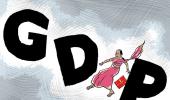The economy has shown sharp resilience in the past and has also bounced back in good time. We could hence expect a similar trajectory next year, observes Madan Sabnavis, chief economist, CARE Ratings.

The first advance estimates of GDP growth for FY21 at -7.7 per cent is in line with our (CARE Ratings) projection of -7.7-7.9 per cent.
This is also like what the RBI has projected at -7.5 per cent for FY21.
The approach to such forecasts is important as the Central Statistics Office extrapolates growth rates based on the most recent numbers that are available for various sectors.
This also means that depending on any significant change that takes place in the last 4-5 months of the fiscal year, there could be some alteration in this estimate.
There could be an upside to this estimate in terms of less negativity though may not be very significant as present conditions show.
What does this number indicate?
The first is that there is shrinkage in GDP perhaps for the first time on account of the lockdown.
Quite clearly the decision to close the economy in March has had fairly sharp impact on overall growth.
The inability to go about doing business had a profound impact on the economy.
Second, this number has been driven by negative growth rates in 7 of the 8 sectors for which data is reported.
Agriculture is the only exception, which again is on expected lines.
Mining, construction and trade, transport etc. are the three sectors with double-digit negative growth rates while manufacturing is to decline by 9.4 per cent.
The fall in manufacturing is a worry because this sector had been a non-performer even before the pandemic with growth of just 0.03 per cent last year.
Third, in terms of expenditure, two of the three main engines will be declining, consumption and investment.
Consumption is to fall by around 6 per cent and investment by 14 per cent.
Both these elements will be future drivers of growth.
The fall can be explained by the decline in incomes due to job losses and pay cuts.
Also, this indicates that the trends of revival in demand witnessed during the festival season could have had a rural bias with farm incomes providing the boost.
In case of investment, it is more due to the private sector still following a wait and watch policy notwithstanding the easy access to liquidity.
The combination of fewer projects on the anvil and the risk-aversion of banks has slowed down investment quite discernibly this year.
This is again a trend witnessed in the last few years and needs to be reversed.
Capital formation is to decline from 26.9 per cent to 24.2 per cent this year.
Fourth, the government story is interesting.
In terms of expenditure there is an increase of around 11 per cent.
However, the segment public administration and other services where the government has a share of 40 per cent, there is de-growth.
This can be explained by the fact that expenditure has been more in the nature of transfer payments rather than addition to value addition.
There will hence be expectation that the government will provide a big push in the Union Budget to be announced soon.
The GDP number in nominal terms is to be Rs 194.81 lakh crore against Rs 203.89 lakh crore last year.
The significance is more from the point of view of the upcoming Budget which will operate on this number when reckoning the fiscal deficit.
The fall in expected GDP in nominal terms would be from a projection of Rs 225 lakh crore to Rs 195 lakh crore which is around 13 per cent.
At the budgeted fiscal deficit level of Rs 7.96 lakh crore, the ratio would slip to 4 per cent automatically.
However, again from the point of view of the Budget, this decline to Rs 195 lakh crore will help in projecting a number of 15 per cent growth in nominal terms (10 per cent real and 5 per cent inflation) which will bring the level to Rs 224 lakh cr which is what was projected for FY21.
The implication hence can be that while there can be myriad expectations from the Budget in terms of the expenditure, the revenue side will be driven by how the overall growth number evolves as it will affect the potential tax revenue.
Hence, it can be said that in a way with a sharp recovery in FY22, the nation has lost one year of growth which would be the approximate economic cost of the lockdown which is still in the partial unlock mode.
The economy has shown sharp resilience in the past and has also bounced back in good time.
We could hence expect a similar trajectory next year.
Madan Sabnavis is chief economist at CARE Ratings and the author of Hits & Misses: The Indian Story.










